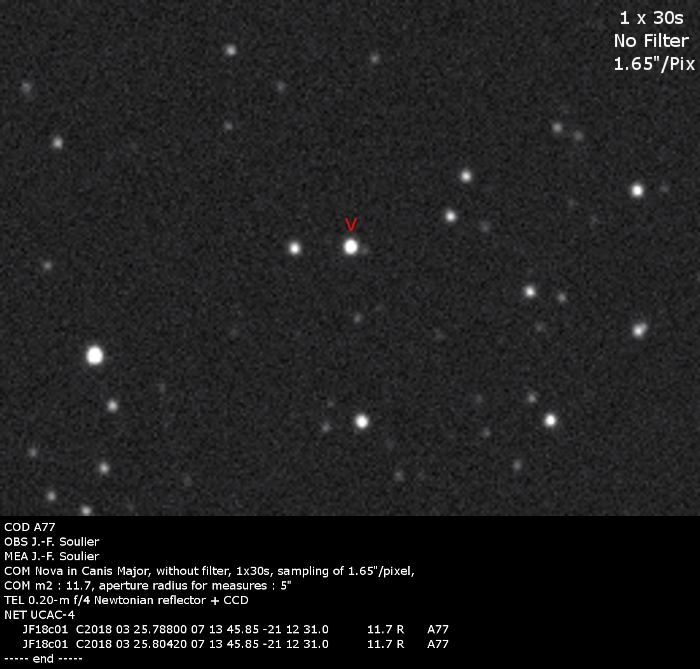

NOVA CANIS MAJORIS 2018 = TCP J07134590-2112330
M. Soma, National Astronomical Observatory of Japan, reports the
discovery of an apparent nova (mag 12.0) by Yuji Nakamura (Kameyama, Mie,
Japan) on a CCD frame (limiting mag 15.1) taken on Mar. 24.496 UT with a
10-cm f/3 reflector; the position of the variable was given as R.A. =
7h13m45s.9, Decl. = -21d12'33" (equinox 2000.0). The object was given the
provisional designation TCP J07134590-2112330 when it was posted by Soma at
the Central Bureau's TOCP webpage. P. Schmeer, Bischmisheim, Germany, writes
that there no previous outbursts or eruptions were recorded by the ASAS-SN
Sky Patrol in Feb. 2012 and since Dec. 2014, and he adds that there is a
faint (magnitude g = 21.6) Pan-STARRS1 source with position end figures
45s.84, 31".3. Additional CCD magnitudes for TCP J07134590-2112330: Mar.
17.511, [15.4 (Nakamura); 23.153, V = 15.5 (ASAS-SN Sky Patrol, as reported
by Schmeer; contaminated by the light of a 15th-magnitude star 9" away);
25.143, V = 12.2 (ASAS-SN Sky Patrol, as reported by Schmeer); 25.411, V =
12.14, R_c = 11.54, I_c = 11.01 (S. Kiyota, Kamagaya, Japan). Schmeer also
reports that he measured visual mag 12.8 on Mar. 24.831.
TCP J07134590-2112330 has been observed spectroscopically (range 385-785
nm; resolution about 1200) by J. Strader et al. with the 4-m Southern
Astrophysical Research Telescope at Cerro Pachon, Chile, on Mar. 25.1 UT, who
write that strong Balmer emission lines with P-Cyg profiles (FWHM of H_alpha
is 1250 km/s, with an absorption trough extending to -2000 km/s) are present,
along with strong lines of [O I] and Fe II -- suggesting that this is a young
classical nova. They add that they believe that the nova is identical to the
Pan-STARRS1 object noted by Schmeer (above). These details are posted at
website URL http://www.astronomerstelegram.org/?read=11475.


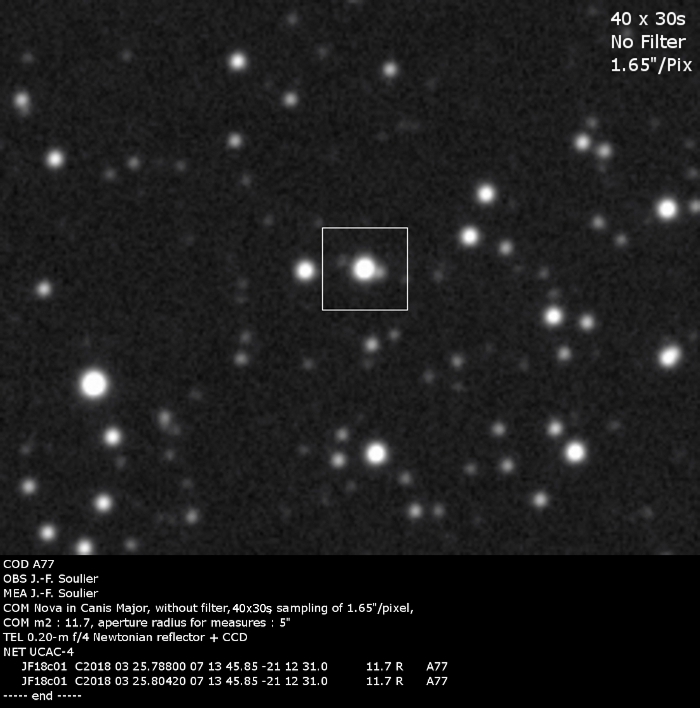
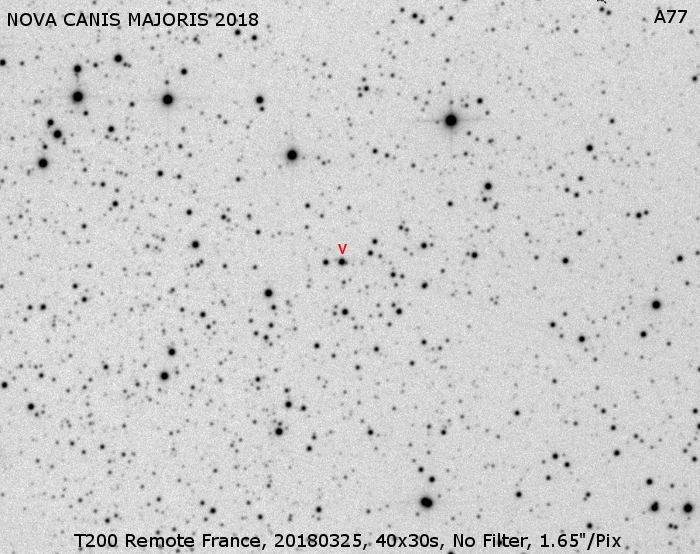
 T400RC Remote SpaceObs., Chile
T400RC Remote SpaceObs., Chile
SUPERNOVA in the M63 => SN 2017dfc (= Gaia17baw)
http://www.rochesterastronomy.org/sn2017/sn2017dfc.html

SN 2017dfc (= Gaia17baw) was discovered on 2017 April 9 with magnitude
of 18.99 mag. It has since risen to 18.10 mag on 2017 April 19
(http://gsaweb.ast.cam.ac.uk/alerts/alert/Gaia17baw/). The SN is
located 28".38 north and 63".73 south of the center of M63 (z =
0.001614; mu = 29.8 mag; NED). If the SN is at the distance of M63, it
would have an absolute magnitude of -10.9 and -11.8 mag for the two
reported photometric epochs, respectively.We obtained spectroscopic
observations of SN 2017dfc with the Kast double spectrograph on the
Shane 3-m telescope on UT 2017 April 21. The spectrum indicates that SN
2017dfc is a type-Ia supernova. Using SNID (Blondin & Tonry, 2007,
ApJ, 666, 1024), we find the best match is a normal SN Ia about 1-2
days before maximum light. However, all the matches from SNID show that
the SN has a redshift of ~0.06. Assuming this redshift, but not
accounting for any reddening from M63 and/or its local environment, SN
2017dfc would have an absolute magnitude of -19.3 on 2017 April 19,
consistent with the brightness of a near-peak SN Ia. Examining SDSS and
PS1 images of the SN position, there is a faint, extended, relatively
red object about 8� to the northwest of SN 2017dfc, which we suggest
may be a background host galaxy.
We conclude that SN 2017dfc is not located in the M63, but instead is hosted by a galaxy behind M63 at z ~ 0.06.
SUPERNOVA 2015ax = PSN J01181560+1505588


SUPERNOVA 2015ax = PSN J01181560+1505588
Francois Kugel, Dauban, Banon, France, reports his discovery of an
apparent supernova (red mag 17.2) on CCD exposures obtained of comet C/2014
A4 by A. Klotz and himself with a 0.20-m f/4 Schmidt-Cassegrain reflector (+
Sloan r' filter) on Oct. 30.827 UT. The new object was measured to have
position R.A. = 1h18m15s.60, Decl. = +15d05'58".8 (equinox J2000.0; reference
stars from USNO-SA2.0 catalogue), which is 12" east and 2" north of the center
of the galaxy 2MFGC 973 in p.a. 78 deg. Nothing is visible at this position
on a red Digitized Sky Survey image of the galaxy. Kugel posted his image at
URL http://fkometes.pagesperso-orange.fr/images/SN_/possSN20151030.jpg.
The variable was designated PSN J01181560+1505588 when it was posted at the
Central Bureau's TOCP webpage and is here designated SN 2015ax based on the
spectroscopic confirmation reported below. Additional CCD magnitudes for
2015ax: Oct. 31.524, 17.2 (Kugel; measured from an image taken by A. Klotz,
D. Turpin, D. Coward, and J. Moore with the 100-cm Zadko robotic telescope
+ "J" filter at Gingin, Australia); 31.766, 17.3 (Kugel; position end figures
15s.54, 59.5); 31.96, 17.7 (P. Dupouy and J.-B. de Vanssay, Dax, France;
0.43-m f/2.7 reflector; position end figures 15s.58, 58".5); Nov. 1.129, 17.3
(A. Maury and J.-F. Soulier; 0.4-m f/8 Ritchey-Chretien reflector at San
Pedro de Atacama, Chile; position end figures 15s.56, 58".1; image posted at
website URL http://6888comete.free.fr/images/forum/SnK1101A.jpg); 1.883, 17.5
(J. Nicolas, Dauban, France; 0.41-m f/3.3 reflector); 1.936, 17.4 (J.-F.
Soulier, Maisoncelles, France; 0.30-m f/3.8 Newtonian reflector; position end
figures 15s.57, 58".5; UCAC-4 reference stars; image posted at website URL
http://6888comete.free.fr/images/forum/SnK1101B.jpg); 2.847, 18.0 (G. Masi;
remotely using a 43-cm telescope at Ceccano, Italy; position end figures
15s.58, 58".2); 4.862, 17.5 (Nicolas).
Liming Rui and Xiaofeng Wang, Tsinghua University; and Tianmeng Zhang,
National Astronomical Observatories of China (NAOC), report on an optical
spectrogram of PSN J01181560+1505588 = SN 2015ax was obtained on Nov. 3.9 UT
with the 2.16-m telescope (+ BFOSC) at the Xinglong Station of the NAOC. The
spectrum is consistent with a type-Ia supernova a few days after maximum
light. Cross-correlation with a library of supernova spectra using the
comparison tool SNID (Blondin and Tonry 2007, Ap.J. 666, 1024) shows that
2015ax matches with SN 2002fk at +4 days. Adopting a redshift of 0.054 for
its host galaxy, FGC 146 (Haynes et al. 2011, A.J. 142, 170), an expansion
velocity of about 9300 km/s can be derived from the absorption minimum of
Si II 635.5-nm.
NOTE: These 'Central Bureau Electronic Telegrams' are sometimes
superseded by text appearing later in the printed IAU Circulars.
(C) Copyright 2015 CBAT
2015
November 24
(CBET 4203) Daniel W.
E. Green
PNV J13544700-5909080 2013 12 02.692 * 13 54 47.00 -59 09 08.0 05.5 U Cen 8 9
2013 12 02.692
Possible new nova in Centaurus. Discovered by John Seach, Chatsworth Island, NSW Australia. Instrument DSLR with 50 mm f/1.0 lens. Visible on 6 images, limiting magnitude 11. Nothing visible on image taken with same instrument on November 26.69 UT 2013 limiting magnitude 11. Nothing visible on variable star index, DSS2-red, or minor planet checker.
2013 12 03.621
Low resolution optical spectrum of PNV obtained, with DSLR @ 200mm and Star Analyser grating. Spectrum shows strong Ha & Hb emission lines. Rob Kaufman, White Cliffs, NSW, Australia. Spectrum available here: http://i727.photobucket.com/albums/ww271/Rob_Kau/PNVJ13544700-5909080spectrum03Dec2013.jpg
2013 12 03.6867
Following the posting on the Central Bureau's Transient Object Confirmation Page about a possible Nova in Cen (TOCP Designation: PNV J13544700-5909080) we performed some follow-up of this object remotely through the 0.50-m f/6.8 astrograph + CCD + focal reducer of ITelescope network (MPC Code Q62 - Siding Spring, AU). On our images taken on December 03.68, 2013 we can confirm the presence of an optical counterpart with unfiltered CCD magnitude ~ 5.0 at coordinates: R.A. = 13 54 45.22, Decl.= -59 09 04.5 (equinox 2000.0; UCAC-3 catalogue reference stars). According to Vizier the nearest star (located at 1.538 arcsecond from this transient) to this position in the USNO-B1.0 catalogue is: USNO-B1.0 0308-0442031 (J2000) 13 54 45.374 -59 09 03.52 mag. B2=15.52 R2 =15.12. An animation showing a comparison between our confirmation image and the archive POSS2/UKSTU plate (R Filter - 1999): http://bit.ly/1bfm4IR - Our confirmation image: http://bit.ly/1cWNPIW - Ernesto Guido, Nick Howes & Martino Nicolini



NET UCAC-4
C2013
12 06.3393813 54 45.28 -59 09
04.1 6.2
R W96
R.o. : 10.35" Bin 2x2
C2013
12 06.3393813 54 45.26 -59 09
03.7 6.0
R W96
R.o. : 20.7" Bin 2x2
C2013
12 06.3494013 54 45.26 -59 09
03.9 4.5
R W96
R.o. : 5.1" Bin 1x1
C2013
12 06.3494013 54 45.26 -59 09
03.9 4.5
R W96
R.o. : 10.2" Bin 1x1
----- end -----
NOVA DELPHINI 2013 = PNV J20233073+2046041
S. Nakano, Sumoto, Japan, reports
the discovery by Koichi Itagaki
(Teppo-cho, Yamagata, Japan) of an apparent
nova (mag 6.8) on an unfiltered
CCD frame taken on Aug. 14.584 UT using a
0.18-m reflector, with confirming
unfiltered images taken with a 0.60-m f/5.7
reflector on Aug. 14.750 that show
the variable at mag 6.3. The new object is
located at R.A. = 20h23m30s.73,
Decl. = +20d46'04".1 (equinox 2000.0).
Itagaki posted his discovery image at
website URL http://www.k-itagaki.jp/images/pnv-del.jpg. The variable
was
designated PNV J20233073+2046041 when it was posted at the Central
Bureau's
TOCP webpage. Additional CCD magnitudes (unfiltered unless noted
otherwise)
for PNV J20233073+2046041: May 13.998, 17.1 (D. Denisenko, V.
Lipunov, E.
Gorbovskoy, A. Parkhomenko, A. Tlatov, D. Dormidontov, and V.
Senik; double
0.40-m f/2.5 robotic MASTER-Kislovodsk reflector; limiting mag
18.9); Aug.
13.565, [13.0 (Itagaki); 14.8, 6.8 (Ernesto Guido, Nello Ruocco,
and Nick
Howes; remotely using a 0.43-m f/6.8 astrograph near Nerpio, Spain;
position
end figures 30s.72, 03".4; UCAC-3 catalogue reference stars); 14.8,
R = 6.1
(Guido et al.; 0.25-m f/6.3 telescope at Sorrento, Italy; unfiltered
mag 6.9;
position end figures 30s.68, 03".7; CMC-14 catalogue reference
stars;
confirmation image posted at website URL http://bit.ly/15FLJaK, with
an
animation comparing their image and a 1990 red Digitized Sky Survey plate
is
posted at URL http://bit.ly/13AVFTy); 14.802, R = 6.4 (Sergey
Shurpakov,
Baran, Belarus; 0.20-m f/4 reflector + Artemis 285AL camera;
position end
figures 30s.95, 05".6; CMC-14 reference stars; image posted at
website URL
http://www.taurusskystars.narod.ru/confirm.html); 14.817, V =
6.2 (Wolfgang
Vollmann, Vienna, Austria; digital SLR camera with 50-mm-f.l.
f/2.8 lens);
14.826, 7.7 (Denisenko et al.; MASTER-Kislovodsk reflector;
limiting mag 18.7;
image posted at URL http://master.sai.msu.ru/static/OT/NovaDel2013-MASTER.jpg);
14.894,
6.8 (Gianluca Masi, Patrick Schmeer, and Francesca Nocentini; remotely
using
the 43-cm robotic telescope at Ceccano, Italy; position end figures
30s.68,
03".7); 14.897, 6.5 (Uwe Reichert, Schwetzingen, Germany; Canon 6D
camera +
180-mm-f.l. f/5.6 lens at ISO 6400); 14.923, B = 6.77, V = 6.10, R =
5.62 (L.
Izzo and L. D'Avino; remotely with a 0.15-m f/7.3 telescope near
Nerpio,
Spain; iTelescope T16); 14.952, B = 6.72, V = 6.66, R = 6.32, B-V =
+0.06 (T.
Yusa, Osaki, Japan; remotely using a 0.43-m f/6.8 astrograph at the
RAS
observatory near Nerpio, Spain); 14.96, 6.6 (P. Bacci, San
Marcello
Pistoiese, Italy; 0.60-m f/4 telescope; animated image posted at
website URL
http://tiny.cc/t5xt1w); 15.14, 6.0 (Quanzhi Ye, London, ON,
Canada; Canon G11
camera).
Visual magnitude estimates for PNV
J20233073+2046041: Aug. 14.821 UT,
6.2 (M. Reszelski, Szamotuly-Galowo,
Poland, 15x70 binoculars); 14.829, 6.0
(Patrick Schmeer, Bischmisheim,
Germany); 14.884, 6.4 (K. Hornoch, Pancir,
Czech Republic, 10x50 binoculars);
14.915, 6.3 (E. Broens, Mol, Belgium);
15.015, 6.3 (R. Fidrich, Budapest,
Hungary, 20x60 binoculars); 15.035, 6.0
(Gustav Holmberg, Lund,
Sweden).
Schmeer adds that there is a star of blue magnitude 17 (and V =
16.86,
from The Guide Star Catalogue, Version 2.3.2) that is located about
0".3 from
the position of the possible nova at position end figures 30s.714,
04".22.
Denisenko et al. suggest that the variable is identical to the blue
star
USNO-B1.0 1107-0509795 (position end figures 30s.713, 03".97; blue mag
17.2-
17.4, red mag 17.4-17.7) and to the ultraviolet source GALEX
J202330.7+204603
(NUV magnitude 17.9); their color-combined (BRIR) Digitized
Sky Survey finder
chart posted at http://master.sai.msu.ru/static/OT/J202330+204604-BRIR5x5.jpg
(field-of-view
5' x 5') has the proposed precursor marked.
Strong H-alpha emission has been
noted by Masi et al. (low-resolution
spectra taken with a 36-cm robotic
telescope at Ceccano; scale about 3.4
nm/pixel; Aug. 14.92 UT) and by Olivier
Garde (Observatoire de la Tourbiere,
France; C14 telescope; resolution 10000;
echelle spectrograph). Further
spectroscopy by Masi et al. on Aug. 15.03
(noting the use of a 100 lines/mm
diffraction grating under better skies)
confirms the emission at H-alpha but
with emission at H-beta also
noted.

NOVA Dauphin : 20130815 21H34TU, 14X120s, Field : 41'x27', R.o : 20" = m2 : +/- 7
SN2013ej


SN2013am

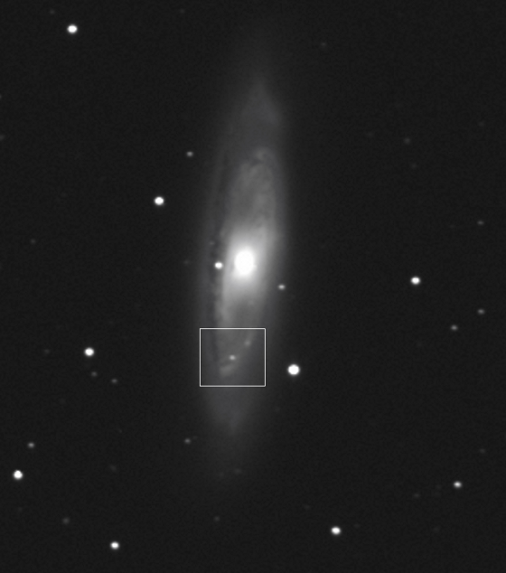
11x120s, no filter, T300 F/D : 3, ST8XME, 20130415
SN2012c


DWARF NOVA IN PEGASUS = PNV J23272715+0855391
Hitoshi Yamaoka, Kyushu University, reports the discovery by K. Itagaki,
Yamagata, Japan, of a possible nova (mag 13.9) on unfiltered supernova-search
CCD images taken on Sept. 13.568 UT with a 0.50-m f/6 reflector. The new
object is located at R.A. = 23h27m27s.15, Decl. = +8d55'39".1 (equinox
2000.0). The discovery image has been posted at the following website URL:
http://www.k-itagaki.jp/images/pnv-psc.jpg. A possible quiescent counterpart
of red magnitude 22.0 is present in the Sloan Digital Sky Survey (DR8),
suggesting a rather large amplitude for a dwarf nova. The variable was
designated PNV J23272715+0855391 when it was posted at the Central Bureau's
TOCP webpage. Additional CCD magnitudes for PNV J23272715+0855391: 2011
Oct. 19.559, [19.0 (Itagaki); 2012 Sept. 13.951, V = 13.9 (Massimiliano
Martignoni, Magnago, Italy; 25-cm f/10 Schmidt-Cassegrain reflector; position
end figures 27s.13, 38".8); 14.163, 13.7 (R. A. Koff, Bennett, CO, USA; Meade
0.25-m f/10 reflector + Apogee U-47 camera; limiting magnitude 18.4; position
end figures 27s.14, 38".8; UCAC3 reference stars; image posted at website URL
http://antelopehillsobservatory.org/SNpictures/PNVJ23272715+0855391final.jpg
<http://antelopehillsobservatory.org/SNpictures/PNVJ23272715+0855391final.jpg>).
M. Dennefeld, Institute d'Astrophysique de Paris and University of Paris
6; M. Valentini, University of Liege; A. Siviero and A. Pizzella, University
of Padova; L. Tomasella, Istituto Nazionale di Astrofisica, Osservatorio
Astronomico di Padova; and the NEON school (cf. IAUC 7664) students M. Cortes
(Spain), N. Ozel (Belgium), and A. Rajpurohit (France), report that a
spectrogram of PNV J23272715+0855391, obtained on Sept. 13.87 UT with the
1.82-m Copernico telescope (+ Afosc spectrograph; range 350-820 nm, resolution
1.3 nm), suggests that this is a dwarf nova. The spectrum shows a strong blue
continuum, with Balmer lines in absorption, and a weak H_alpha emission inside
the absorption. A weak He II (468.6 nm) emission line is possibly present.
No other emission is seen and no P Cyg profiles detected. The Ca II doublet
(393.3-396.7 nm) is also seen in absorption. The spectrum best resembles an
object designated by Liu and Hu (2000, Ap.J. Supp. 128, 387) as "Cet1", also
known as PG 0240+066 in the master catalogue of cataclysmic variables by
Downes et al. (1997, PASP 109, 345).
NOTE: These 'Central Bureau Electronic Telegrams' are sometimes
superseded by text appearing later in the printed IAU Circulars.
(C) Copyright 2012 CBAT
2012 September 14 (CBET 3228) Daniel W. E. Green


Picture : 1x120s
SN2012cg
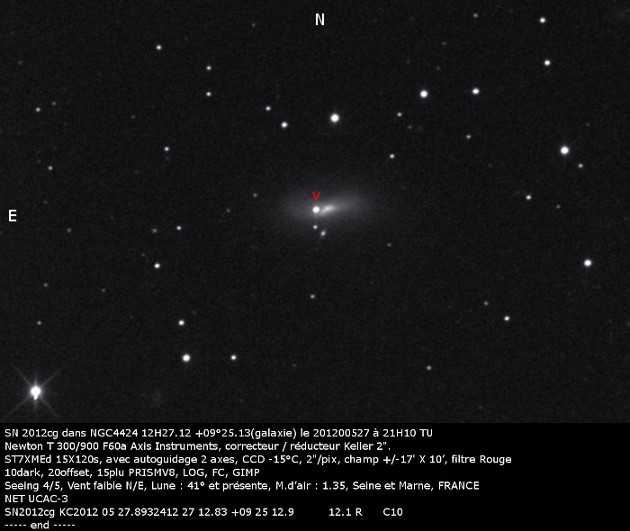
SN2012aw

SN2011fe

SN2011dh



lectronic Telegram No. 2710
Central Bureau for Astronomical Telegrams
INTERNATIONAL ASTRONOMICAL UNION
CBAT Director: Daniel W. E. Green; Hoffman Lab 209; Harvard University;
20 Oxford St.; Cambridge, MA 02138; U.S.A.
e-mail: cbatiau@eps.harvard.edu (alternate cbat@iau.org)
URL http://www.cbat.eps.harvard.edu/index.html
Prepared using the Tamkin Foundation Computer Network
SUPERNOVA 2011ca IN NGC 4495 = PSN J12312490+2907500
F. Ciabattari and E. Mazzoni, Borgo a Mozzano Italy, report the discovery
of an apparent supernova on unfiltered CCD images (limiting mag about 19)
obtained on Apr. 26.94 (when the object was at mag 17.2) and 27.88 UT (at mag
17.1) with a 0.5-m reflector. The new object (which was designated PSN
J12312490+2907500 when posted on the Central Bureau's TOCP webpage and is
here designated SN 2011ca based on the spectroscopic report below) is located
at R.A. = 12h31m24s.94, Decl. = +29d07'50".6 (equinox 2000.0; astrometry with
respect to UCAC2 stars), which is 24" east and 20" south of the center of the
galaxy NGC 4495. Additional magnitudes for 2011ca (via unfiltered CCD unless
otherwise noted, and via Ciabattari and Mazzoni unless otherwise noted):
1990 Jan. 29, [20.3 (Digitized Sky Survey; Palomar F plate); 1990 Mar. 23,
[20.3 (DSS; Palomar J plate); 2011 Apr. 5, [19.1; 28.190, 16.8 (Joseph
Brimacombe, Cairns, Australia; remotely using a 51-cm RCOS telescope + STL11K
camera at the New Mexico Skies Observatory, Mayhill, NM, U.S.A.; position
end figures 25s.00, 50".9). Brimacombe's image is posted at website URL
http://www.flickr.com/photos/43846774@N02/5668046246/. Supernovae 1994S and
2010lo also appeared in NGC 4495.
G. H. Marion, Harvard-Smithsonian Center for Astrophysics (CfA), on
behalf of the CfA Supernova Group, reports that a spectrum (range 340-740 nm)
of PSN J12312490+2907500 = SN 2011ca was obtained on Apr. 30 UT by P. Berlind
with the F. L. Whipple Observatory 1.5-m telescope (+ FAST). Cross-
correlation with a library of supernova spectra using the "Supernova
Identification" code (SNID; Blondin and Tonry 2007, Ap.J. 666, 1024) shows
that the object is a type-Ic supernova about one week after maximum light.
SN2009jf


Je rappelle que :
I recall that : "All images and text from my site are protected by international law
copyright and may not be used in any form whatsoever without
written permission of its author".